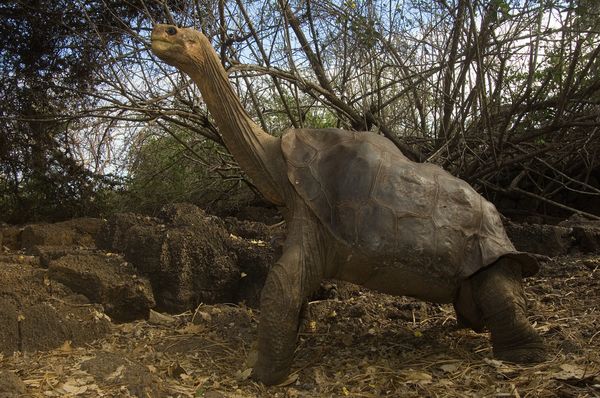Lonesome George to Be Stuffed, Displayed at NYC Museum
A photo of Lonesome George, the last surviving tortoise of his species.
Lonesome George, the iconic giant tortoise of the Galápagos who died last June at over a hundred years of age, is getting stuffed.
Taxidermists at New York City's American Museum of Natural History recently received the frozen body of the deceased animal, and they are now doing the painstaking work—measuring, molding, and casting—to ready him for his museum debut this winter. The final George will include his actual skin and shell fit over a custom-made foam structure that mimics his anatomy.
"Doing taxidermy on a tortoise is much like working on an elephant," said George Dante, the lead taxidermist on the project. "There's no fur, so we have to work to preserve the skin, maintaining its natural color and texture as much as possible, sculpting the wrinkles so they are anatomically accurate. There's very little room for error."
In the final product, which will take six to seven months to complete, only the eyes will be "unnatural."
"Everything else you see is what you'd see looking at the live animal," said Chris Raxworthy, the museum's curator of herpetology. Even the pose must be just so, he said, "to be accurate and to capture the spirit of George. We want to demonstrate the neat features he had—a long neck and unique shell morphology that let him stretch way up, an adaptation that would have helped him to reach food on a dry island like Pinta."
Beginning this winter, the new old George will be on display in New York for an as-yet-undecided amount time before being shipped back to Ecuador's Galápagos Islands, his true home.
First found in 1971 all by himself on Pinta Island in the Galápagos, George was believed to be the last member of his species left alive. Overharvesting by people had taken out his kin, while introduced goats had demolished his habitat. With nothing left for him on Pinta, George was moved to the Charles Darwin Research Station on Santa Cruz Island—operated by the Charles Darwin Foundation—to live out his long life.
For a time he had company: two females of a closely related species from Isabella Island. But the matchmaking failed to produce any hybrid babies, to everyone's disappointment.
In reality, DNA from George's ancestors lives on in tortoises in a remote area of the islands called Volcano Wolf, according to studies published last year by Yale University researchers.
Genetic testing there revealed 17 hybrid descendants of George's species, suggesting there may also be purebred specimens wandering around. If they can be found, scientists hope to bring George back through captive breeding to create a whole new bale—the term for a group of tortoises—to repopulate islands where his kind lived before.
Slow Recovery
And whatever is discovered at Volcano Wolf, repopulation with George-esque animals has already begun.
In May conservationists delivered 39 captive-bred hybrid tortoises to Pinta, George's birthplace, in hopes of restoring that island's ecosystem to a more natural state.
The destructive goats—a population that rose from just three individuals back in the late '50s to some 40,000 at the turn of the century—were eradicated in 2003, and since then the island's flora has boomed.
Still, the island needs its tortoises, according to Linda Cayot, a science advisor at the Galápagos Conservancy.
The animals' eating habits and movements help shape the environment by opening up the land and spreading seeds. In an interview with Scientific American, Cayot called the tortoises "the natural habitat engineers of Galápagos," vital to bringing the Galápagos wilderness back to life.
In the meantime George will be seen again in New York, a mounted specimen with neck long and head held high, his role as a conservation and evolutionary icon forever preserved.
Jennifer S. Holland
for National Geographic
Published July 2, 2013












